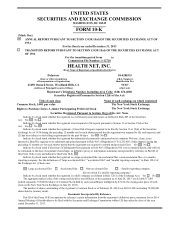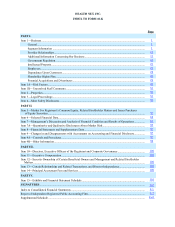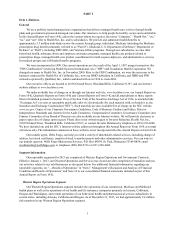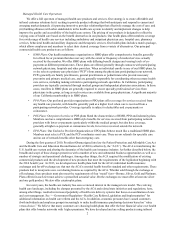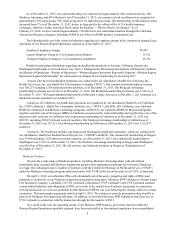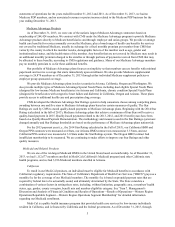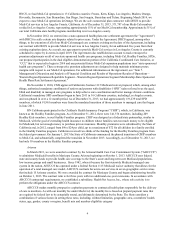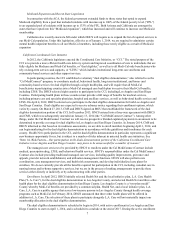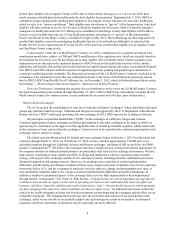Health Net 2013 Annual Report Download - page 10
Download and view the complete annual report
Please find page 10 of the 2013 Health Net annual report below. You can navigate through the pages in the report by either clicking on the pages listed below, or by using the keyword search tool below to find specific information within the annual report.8
period, dual eligibles in Los Angeles County will be able to either choose among us, L.A. Care or one of the three
newly announced health plans for benefits under the dual eligibles demonstration. Beginning July 1, 2014, DHCS is
scheduled to begin automatically enrolling dual eligibles in Los Angeles County who have not selected a health plan,
which we refer to as “passive enrollment.” Dual eligibles may also choose to “opt out” of the demonstration. Such dual
eligibles will then continue to receive fee-for-service Medicare benefits but will receive Medi-Cal benefits through a
managed care health plan under the CCI. During active enrollment in San Diego County dual eligibles will be able to
select to receive benefits from any one of four health plan options, including us, or “opt out” of the demonstration.
Passive enrollment in San Diego County is scheduled to begin in May 2014. The methodology for allocating passively
enrolled dual eligibles across the participating health plans has not yet been finalized, although it is estimated that
Health Net will receive approximately 47% and 20-25% of the passively enrolled dual eligibles in Los Angeles County
and San Diego County, respectively.
Compensation. Under the Cal MediConnect Contract, we will be compensated on a capitated, prospective per-
member-per-month basis, subject to CMS and DHCS modification of the capitation rates, which are currently based on
the historical fee-for-service cost for providing care to dual eligibles. The Cal MediConnect Contract includes a risk
adjustment process that adjusts the capitation payment to HNCS based on the health characteristics of the enrollee
population, and includes risk corridor provisions that limit our upside financial gains and reduce our downside financial
risk. DHCS and CMS will also withhold a portion of capitation payments pending and payable upon satisfaction of
certain pre-established quality standards. The financial performance of the Cal MediConnect Contract is included in the
calculation of the settlement account that was established pursuant to the terms of the Settlement Agreement entered
into by DHCS, HNCS and Health Net of California, Inc. on November 2, 2012, which is further discussed above under
the heading “—Western Region Operations Segment—Medicaid and Related Products.”
Term and Termination. Assuming that no party elects to terminate or not to renew the Cal MediConnect Contract,
the duals demonstration will continue through December 31, 2017. CMS or DHCS may immediately terminate the Cal
MediConnect Contract for various reasons, or may terminate for no reason with 180 days’ prior written notice.
Western Region Exchanges
The ACA required the establishment of state-run or federally facilitated “exchanges” where individuals and small
groups may purchase health coverage. California and Oregon received approval by the U.S. Department of Health and
Human Services (“HHS”) and began operating state-run exchanges in 2013. HHS operates the exchange in Arizona.
We participate as Qualified Health Plans (“QHPs”) in the exchanges in California, Oregon and Arizona.
Continued participation in these exchanges and future participation in any other exchanges in the states in which we
operate may be conditioned on the approval of the applicable state or federal government regulator, which could result
in the exclusion of some carriers from the exchanges. Certain factors to be considered for continued participation in the
exchanges may be subject to change.
The initial open enrollment period for federal and state exchanges began on October 1, 2013 for individuals and
continues through March 31, 2014. As of February 25, 2014, we have enrolled approximately 136,000 active new
individual members through the California, Arizona and Oregon exchanges, including 85,000 in our Silver tier HMO
product, CommunityCareSM. We believe the exchanges represent a significant new commercial business opportunity for
the company and that our tailored network products are particularly well suited to the exchange environment. We have
made and are continuing to make significant efforts to design and implement a cohesive operational and economic
strategy with respect to the exchanges and the ACA’s relevant provisions, including premium stabilization provisions
designed to apportion risk amongst insurers. However, the exchanges have experienced certain implementation
difficulties, and the timing and ultimate resolution of these issues remains uncertain. In addition, the relevant regulatory
framework for the ACA, and the exchanges in particular, has been subject to change and interpretation over time, as
state and federal regulators adapt to the various associated implementation difficulties and political landscape. In
addition, a number of operational aspects of the exchanges have yet to be fully implemented or been implemented
through interim “workarounds.” See “Item 1A. Risk Factors—Federal health care reform legislation has had and will
continue to have an adverse impact on the costs of operating our business and could materially adversely affect our
business, cash flows, financial condition and results of operations,” and “—Various health insurance reform proposals
are also emerging at the state level, which could have an adverse impact on us,” for additional discussion on the risks
related to the health exchanges and state and federal government actions impacting the exchanges and the effect on our
competitive landscape. This changing framework may alter the economics and structure of our participation in the
exchanges, and if we are not able to successfully adapt to any such changes in certain of our markets, our financial
condition, cash flows and results of operations may be materially adversely affected.

